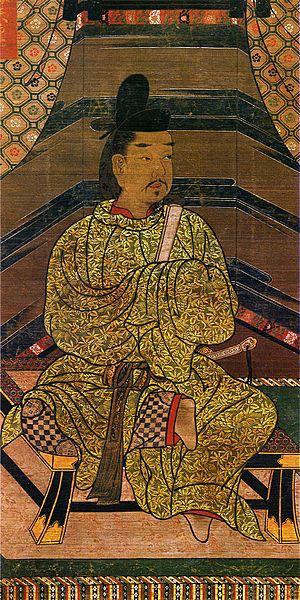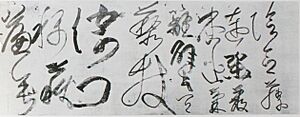Emperor Daigo facts for kids
Quick facts for kids Emperor Daigo醍醐天皇 |
|||||
|---|---|---|---|---|---|

Emperor Daigo
|
|||||
| Emperor of Japan | |||||
| Reign | August 4, 897 – October 16, 930 | ||||
| Coronation | August 14, 897 | ||||
| Predecessor | Uda | ||||
| Successor | Suzaku | ||||
| Born | 6 February 884 Heian Kyō (Kyōto) |
||||
| Died | 23 October 930 (aged 46) Heian Kyō (Kyōto) |
||||
| Burial | Nochi no Yamashina no misasagi (後山科陵) (Kyoto) | ||||
| Spouse | Fujiwara no Onshi | ||||
| Issue more... |
|||||
|
|||||
| House | Yamato | ||||
| Father | Emperor Uda | ||||
| Mother | Fujiwara no Inshi | ||||
Emperor Daigo (醍醐天皇, Daigo-tennō) was the 60th emperor of Japan. He ruled from 897 to 930. He is known for ruling Japan without the help of the powerful Fujiwara family for most of his time as emperor. His name, Daigo, comes from the place where he was buried.
Contents
Emperor Daigo's Family and Early Life
Emperor Daigo was the oldest son of Emperor Uda, who was the emperor before him. His mother was Fujiwara no Taneko. Sadly, his mother passed away before he became emperor. Because of this, another wife of Emperor Uda, Fujiwara no Onshi, helped raise him.
Interestingly, Daigo was not born as a royal prince. His grandfather, Emperor Kōkō, had made his sons ordinary citizens to save money and reduce their power. They were given the family name Minamoto. So, Daigo was first named Minamoto no Korezane.
In 887, his father, Minamoto no Sadami, became an Imperial Prince again and was chosen to be the next emperor. After this, Daigo's personal name was changed to Atsuhito before he became emperor.
Emperor Daigo had many children. He had 21 empresses, consorts, and concubines, and a total of 36 sons and daughters.
Key Events During Daigo's Reign
Emperor Daigo's rule lasted for 34 years, from 897 to 930. A major achievement of his reign was that he governed Japan by himself. This was unusual because the powerful Fujiwara clan often acted as regents, helping emperors rule.
Here are some important events that happened during his time as emperor:
- August 4, 897: Emperor Uda stepped down from the throne, and his oldest son, Daigo, became the new emperor.
- August 14, 897: Emperor Daigo officially took the throne in a special ceremony.
- December 7, 899: On the day the sun reached its lowest point in the sky (winter solstice), important officials from all over Japan came to Daigo's court.
- February 2, 900: Daigo visited his father, Emperor Uda, in the place where Uda lived after giving up the throne.
- 900: Former Emperor Uda traveled to Mount Kōya (高野山), a famous mountain with temples in what is now Wakayama prefecture.
- January 23, 901: There was an eclipse of the sun.
- 901: An event involving a famous scholar named Sugawara Michizane happened. However, Emperor Daigo ordered that all diaries and records from this time be burned, so many details are unknown.
- 906: A famous collection of Japanese poems called the Kokin Wakashū was presented to the emperor.
- 909: Fujiwara no Tokihira, a very important official, passed away at age 39. He was given the special title of regent after his death.
- 929: Big floods hit the country, and many people lost their lives.
- July 21, 930: A huge, dark storm cloud appeared over Heian-kyō (Kyoto), bringing scary thunder and lightning. Lightning struck the Imperial Palace. Several officials were killed, and fires started. People believed this was an act of revenge by the spirit of the late Sugawara Michizane.
- October 16, 930: After 34 years as emperor, Daigo became very sick. Fearing he might not live, he decided to step down from the throne. His son, Prince Hirokira, then became the new emperor, known as Emperor Suzaku.
- October 23, 930: Emperor Daigo became a Buddhist monk very early in the morning. He took the Buddhist name Hō-kongō. He passed away shortly after, at the age of 46. He was buried at Daigo-ji temple, which is why his posthumous name became Daigo-tennō.
Emperor Daigo also ordered the building of several halls at the Daigo-ji temple, like the Yakushi hall. His burial place is known and is honored at a Shinto shrine in Kyoto.
Important Officials During Daigo's Time
The Kugyō (公卿) was a small group of the most powerful men in the emperor's court before the Meiji period. This group usually had only three or four men at a time. These were experienced courtiers who had reached the highest levels in their careers.
During Emperor Daigo's reign, some of these top officials included:
- Sadaijin (Minister of the Left): Fujiwara no Tokihira (871–909) and Fujiwara no Tadahira (880–949).
- Udaijin (Minister of the Right): Sugawara no Michizane (845–901), Minamoto no Hikaru (845–913), Fujiwara no Tadahira, and Fujiwara no Sadakata (873–932).
Eras of Daigo's Reign
In Japan, years are also counted using special era names called nengō. Here are the eras during Emperor Daigo's reign:
Emperor Daigo's Family and Children
Emperor Daigo had many children with his empresses and consorts. Here are some of his most notable family members:
- Empress (Chūgū): Fujiwara no Onshi, daughter of Fujiwara no Mototsune.
- Imperial Prince Yasuakira (903–923): He was Emperor Daigo's crown prince, meaning he was next in line for the throne.
- Imperial Prince Hirokira: He later became Emperor Suzaku.
- Imperial Prince Nariakira: He later became Emperor Murakami.
- Consort (Nyōgo): Minamoto no Washi (d.947), daughter of Emperor Kōkō.
- Imperial Princess Keishi (903–923)
- Imperial Prince Tsuneakira (906–944)
- Imperial Prince Noriakira (907–966)
- Imperial Prince Ariakira (910–961)
- Court Attendant (Koui): Minamoto no Fūshi/Kaneko.
- Imperial Prince Yoshiakira (903–927)
- Court Attendant (Koui): Minamoto no Chikako (d.935).
- Imperial Princess Kinshi (904–938)
- Imperial Prince Tokiakira (912–927)
- Minamoto no Takaakira (914–982): A very important official known as Nishinomiya Sadaijin.
See also
 In Spanish: Daigo Tennō para niños
In Spanish: Daigo Tennō para niños
- Emperor of Japan
- List of Emperors of Japan
- Imperial cult
- Minamoto clan
Images for kids



